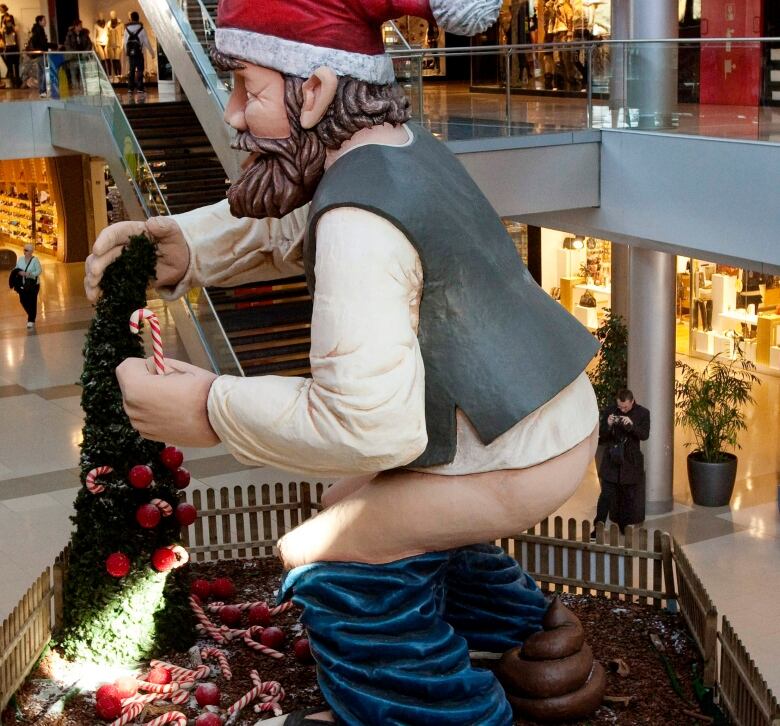Why you should lie to your kids about Santa — and other messy Christmas traditions

By Anna-Liza Kozma
This is a updated version of an earlier essay written in 2009.
The other day my husband came in through the door from his commute with snow clinging to his beard and we're-not-sure-what falling from his boots.
"I just walked through Bethlehem on my way home," he announced, adding that he'd narrowly avoided stepping in donkey dung.
Every second year, farmers and amateur actors in the small town I live in north of Toronto transform the park near the library into a living nativity scene, with sheep and cows, and kids dressed in dressing gowns over snowsuits.
On a good year, you'll see Roman soldiers on horseback bearing flaming torches.
It's quite impressive and whatever your religious beliefs the pageant draws you in to thinking about the 2,000-year-old Christmas story.
Dinosaurs and mangers
In my house, we have a manger scene of our own. I brought the olive-wood manger back from Jerusalem some years ago and added a few ceramic figures from my childhood.
Every year my kids mix in a few of their toys to keep it lively. This year there's a snarling, blue tyrannosaurus sheltering in the barn and a Barbie riding a unicorn.
The chipped crib around which they cluster remains empty until Christmas morning when one of the kids will pluck the plaster infant from its cotton swaddle and plump him in the manger.
We also have a plastic Santa Claus hovering in the wings — or Father Christmas, as we used to call him when I was growing up in a different part of the world.
We tell the kids that his original name was Saint Nicholas and he was a friend of the baby Jesus and of children.
Right now this makes sense to them, but I can see things getting more complicated real soon.
Lying about Christmas
Many years ago, I produced a Christmas program for CBC Radio's Tapestry in which the guest was Margaret Visser, the exuberant Canadian anthropologist of everyday life.
She was there to talk about the Santa myth.
Now, as a parent, I sometimes wonder what kind of trickery am I pushing forward to celebrate the spirit of the season?- Anna-Liza Kozma
Visser mused about the odd sexual imagery of a red-faced man, round and feminine but with whiskers, squeezing down a chimney. And what is it with the third-trimester sized belly and the falling down trousers?
Then she said something really shocking. "I was seven when I realized that my parents lied to me about Santa Claus. And I started wondering what else they were lying to me about."
I didn't have any kids at the time, but that admission has haunted me ever since.
Now, as a parent, I sometimes wonder what kind of trickery am I pushing forward to celebrate the spirit of the season?
How much Christmas jiggery-pokery do I engage in without actually lying to my offspring? And what is the dominant seasonal story we should be celebrating anyway?

Fooling the old people
I've been talking to a few parents about the Santa conundrum and most of us feel more than a bit conflicted.
"I try not to actually lie," says my babysitter, Marg. "But I don't want to spoil the magic."
"I say Santa is a fun story to believe in," says another friend, Lisa. "But my husband tends to ham it up and has convinced the kids that he is real."
It didn't help much when my Grade 1 daughter brought home a baggie of oatmeal and glitter for the lawn, announcing that it was "reindeer food to help guide Santa's sleigh to our house."
Friends in England had a brilliant ploy. They told their three kids that there are adults, including their grandparents, who really enjoy believing that Father Christmas travels round the world on a sleigh loaded with presents.
"We don't want to spoil it for grandma and grandpa, do we?" they used to say.
The kids gamely went along for years, exchanging knowing grins among themselves, enjoying the feeling of being in on the secret: The sense of play and make-believe.

The Family Conspiracy
This is the attitude Canadian historian Gerry Bowler favours. He's the author of a wonderful book called The World Encyclopedia of Christmas and an enthusiast for seasonal traditions, including perpetuating the Santa myth. I told him about Margaret Visser's deep shock when she realized her parents had lied to her.
One of the reasons that Christmas is so powerful is that it absorbs all kinds of meaning.- Gerry Bowler
"You do sometimes hear stories of existential angst," he told me. "But usually around the age of six or seven, children gradually begin to suspect that Santa Claus is a big game. And there's a feeling of pride that comes with working that out for themselves. They are admitted to the family conspiracy."
When Gerry Bowler was around six, he secretly marked the orange his parents put out as a snack for Santa. When he discovered the same orange in his stocking the next morning, "I knew the jig was up," he said.
"I was proud of figuring it out myself."
The glittery reindeer food our kids bring home from school to put out on Christmas Eve is one of hundreds of threads that connect us to a rich tapestry of ancient, mostly forgotten customs. Traditions that Bowler believes are worth preserving whether you're leaving cold beer out for the kangaroos who pull the sleigh in Australia or milk and cookies for Santa in Canada.

The Thin Veil Between Worlds
"One of the reasons that Christmas is so powerful is that it absorbs all kinds of meaning," said Bowler. "Leaving food out on Christmas Eve comes from pagan customs for remembering the family dead. This was Christianised to leaving food out for the Holy Family and then becomes food for Santa today."
These traditions... remind us we are all pilgrims on this same journey.- Gerry Bowler
"In past times people felt the spirits of departed family members were particularly close at Christmas," Bowler told me. "The veil between this world and the next was much thinner. People believed our actions here could do good to the dead." Today, the tradition of tending family graves continues in Eastern Europe and many cultures leave out an extra plate at the feast for family that have passed on.
But for Christians today, aren't these strange customs mere frippery, sidelines to celebrating the Nativity?
Not really, says Bowler. "These traditions treat the family as something greater than just the nuclear unit that happens to exist at the moment. They emphasize spirituality over materiality and link us to the past. They remind us we are all pilgrims on this same journey."
Something elemental
Whatever your tradition, there is something worth salvaging from the glitz and the curled-ribbon gifts and the Zambonis made out of gingerbread. Yes this is a thing.
There is something elemental about Christmas, regardless of whatever problems we can all have with some of its underlying stories.
For me, this is the whole point of the season, the story to pass on to our children.- Anna-Liza Kozma
On those days when I wonder about the point of the Christmas story, I think of the Catalonians.
You can't beat them for celebrating the elemental humanity of this religious feast day in all its wonderful weirdness.
If you look closely at a nativity scene in Barcelona's plazas and family homes you will often find a little man crouched on his haunches, with his trousers around his ankles.
He may be hidden behind a bush or among the lambs, usually a decent distance from the baby Jesus. He's called a caganer — literally, a shitter.
And he's a traditional good luck figure to the Catalonians ensuring fertile soil, health and happiness in the coming year.

Enjoy the fabulous
Every few years in Spain, one local council or other tries to ban the pooping man from public crèches. For some, he is considered to be an embarrassing throwback to a more rustic time, before chemical fertilizers and indoor plumbing.
Others put a modern spin on the caganer and have transformed him into squatting soccer players or prominent politicians, including the now hot-selling Obama figurine, and now the Trump version.
For me, this is the whole point of the season, the story to pass on to our children.
It is the bringing together of the high and the lowly, the historical and the fabulous.
In the words of an old Dickensian carol, anyone who wants it has a place at the manger: "All poor men and humble, all lame men who stumble, come haste ye and be not afraid."
Room in the stables
That invitation to outcasts even includes us modern, harassed parents, offers the Anglican Church of Canada.
Those of us who are reluctant to bring wailing, fidgety kids to candlelight services. Who fear turning the hushed solo into a not-so Silent Night.
Local churches put on Messy Christmas, informal, family-friendly services where snacks are plentiful and you can sneak out for washroom breaks. Which brings me back to the living nativity and my husband walking through our version of Bethlehem, dodging the donkey dung.
A baby in a barn full of animals is a welcome reminder of our humanity, seasoned with just the right sprinkle of sentimentality.
As anyone who has ever changed a diaper knows, there's always going to be poo to deal with. And there's always room for another caganer by the manger.